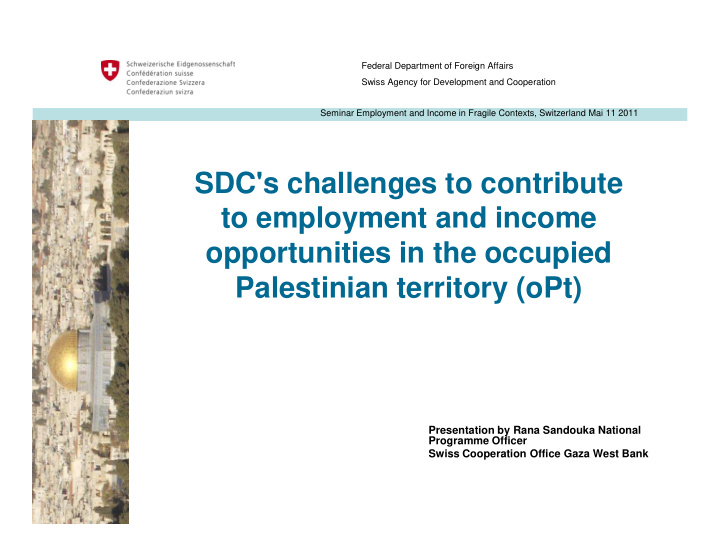



Federal Department of Foreign Affairs Swiss Agency for Development and Cooperation Seminar Employment and Income in Fragile Contexts, Switzerland Mai 11 2011 SDC's challenges to contribute to employment and income opportunities in the occupied Palestinian territory (oPt) Palestinian territory (oPt) Presentation by Rana Sandouka National Programme Officer Swiss Cooperation Office Gaza West Bank
Context: Socio-Economic • Population 4 Million (2,5 in WB & 1,5 in GS) • P alestinian N ational A uthority ( PNA ) established in 1994 • Unemployment :15.2% in WB & 39% in GS (highest among youth) • Large inflow of foreign assistance ( 50% of GDP ) • 22% of population living below poverty line • Breakdown of Gaza economy (war, blockade); slight unsustainable recovery • First economic growth in WB since decade (not sustainable: aid- driven, low reference basis, underdev. industry & service dominated.
Fragile Context – Protracted Conflict Occupation: - Territorial fragmentation (Gaza Strip vs. West Bank & within WB: East Jerusalem, area A, B, C) - Severe access and movement restrictions on people and goods restrictions on people and goods within WB to & from GS and WB (checkpoints, barrier, blockade) Leading to: - PNA full control over 2% of WB - De facto Hamas gov. Controlling GS - Yet no freedom to promote any viable economic policies
SDC E+I projects in the oPt Enhancing competitiveness of value chains with a high market and employment potential West Bank: • Support to olive oil sector : enhancing production, improving management and market orientation of cooperatives • Support to fresh fruit and vegetable producers : improving access to markets, upgrading management and marketing skills to markets, upgrading management and marketing skills Gaza Strip: • Rehabilitation of productive infrastructure : land and wells rehabilitation for agricultural production • Emergency – Poor to Poor : Buying agricultural products from poor farmers and distributing them war affected families IHL/HR: • A strong advocacy component in the Rule of Law and Protection domain for the benefit of Palestinians access
Results in the agricultural sector • 26 product specifications for fruits and vegetables developed and adopted by Palestinian Standards Institute • 30 cooperatives apply improved cultivation practices and access to local & international markets (e.g. Fair Trade) • Creation of InTajuna Label (Our Production) increased share of Palestinian fresh fruits and vegetables in domestic market • 40 wells and 250 dunums of agri. land rehabilitated • Change of attitude of implementing partners: market orientation instead of relief (subsidy)
Main challenges to market development (1) • Occupation severely limits access of farmers to and control over productive assets (e.g. land, water, production inputs) – limited scope to exploit productivity potentials and achieve aggregated and sustainable development achieve aggregated and sustainable development results in terms of employment and income – Brain drain: difficulty to maintain sector knowledge
Main challenges to market development (2) • Dysfunctional agricultural markets/market environment: – High transaction costs due to conflict/occupation – Root causes of “dysfunctionality” related to conflict – Root causes of “dysfunctionality” related to conflict cannot be addressed in the frame of a project – Need to target less complex, more controllable markets or niche markets that are less affected by market distortions (e.g. domestic markets, niche markets, selected value chains)
Main challenges to market development (3) • High risk for daily work and investment – Destruction of assets, confiscation, volatile access to markets, settler violence – Designing of adequate risk mitigation/sharing mechanisms with minimal direct subsidies. – Keeping focus on promotion of entrepreneurship instead of creating recipients
Main limitations to market development (4) • Politics before good practices: – Thin line: contribution to sustainable employment and income opportunities in the agricultural sector vs. direct subsidy policy of donors – what is realistic under a protracted occupation versus the political interest of donors? – Conflict sensitivity: donors do not deal with de facto authorities in Gaza..... – Impartial promotion of e+i requires sound assessment of partner organisations and their political affiliation as well as their geographical coverage
SDC‘s strategy in this particular context (1) • Shift of approach: – more comprehensive value chain view in order to identify entry points – from subsidizing beneficiaries towards strengthening their position in the market – strong component of capacity building of implementing partners in new approaches is required (value chain, M4P) • Improved complementarity of humanitarian and development instruments • Strong advocacy component for the respect of International Humanitarian Law (IHL) and Human Rights: link to other SDC Country Strategy domain
SDC‘s strategyin this particular context (2) • Stronger engagement in donor coordination to advocate for more coherent and market oriented approaches vs. subsidising practices • Being more inclusive through working with different stakeholders along political and geographical lines/areas
Private Sector role in the fragile context of oPt • PS needs to generate funds (taxes) to finance public goods (schools, security etc.) • Employment provides perspective thus reducing conflict • Employment provides perspective thus reducing conflict potential • Business as a connector between different conflict lines • PS advocating for PA accountability and creation of a more conducive framework conditions
Interesting Links • http://www.youtube.com/watch?v=AcZMH0aCWKo • www.ocha.ps • www.apis.ps • http://www.mfa.gov.il/MFA/Peace+Process/Guide+to+the+Peace+Pr ocess/Gaza-Jericho+Agreement+Annex+IV+- +Economic+Protoco.htm • http://www.unctad.org/en/docs/gds20092_en.pdf
Recommend
More recommend